Must new houses mean new roads? Campaigners and councils clash

Can you have new houses without new roads? Until now, received wisdom in Oxfordshire has always been that one requires the other – but campaigners are now calling this into question.
The south of the county, including South Oxfordshire and the Vale of White Horse, has been earmarked for up to 40,000 new homes. (With a new Government in power, the exact figure is hard to forecast.)
In recent weeks, the Clarion has reported on developments across Oxfordshire including those at Begbroke, Culham and Heyford Park where rail travel is part of the mix. But much new housing is not within easy reach of a railway, and new residents may wish to travel by car anyway.
Central Government is paying for new roads to serve the developments across the south of the county, via the Housing Infrastructure Fund (HIF) and the Housing Growth Deal. These deals were inked during the time of Oxfordshire County Council’s previous Conservative administration. The Conservatives no longer run any Oxfordshire councils, but the road programmes continue, closely linked to the housing targets required of the area.
Transport throwback or necessary evil?
In 2022, a campaign group was established to fight these plans, the Oxfordshire Roads Action Alliance (ORAA). It is supported by groups including parish councils in the Thames valley around Didcot; CPRE, the countryside charity; and Oxford Friends of the Earth.
Speaking to the Clarion, ORAA said that the Didcot Relief Road HIF1 scheme and the Watlington Relief Road would join up to form a major new expressway between the A34 and M40 junction 6. They claim this would transform the rural south of Oxfordshire, and lead to the emergence of new rat runs along this corridor:
“We believe that the County should pause any further new road building and review how transport and planning policies interact so that new housing does not swamp South Oxfordshire with traffic or destroy the countryside.”
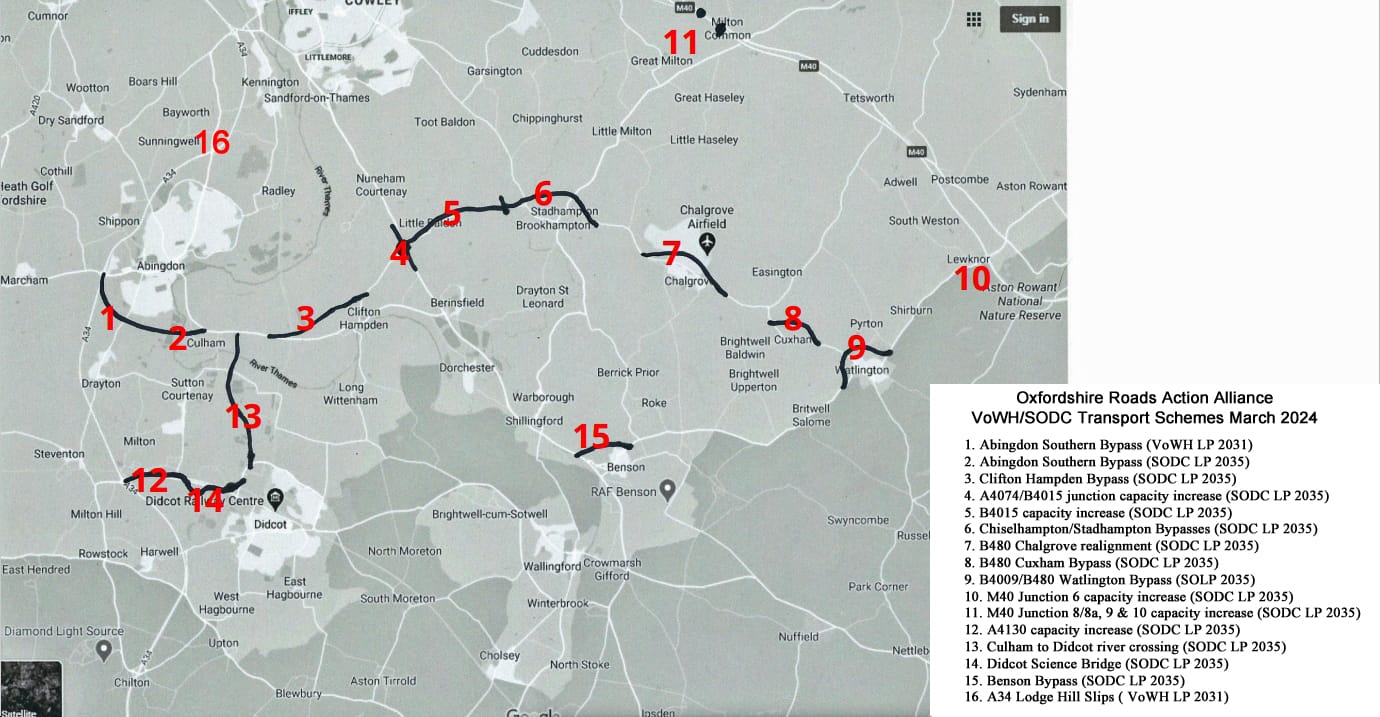
Nationally, the Department for Transport is reviewing the transport infrastructure projects inherited from the previous government, including several new roads. But these are only the roads being built by National Highways, the central body for motorways and trunk roads. Local schemes such as those in southern Oxfordshire have largely escaped national attention. ORAA says the county council should follow the national lead and conduct its own transport infrastructure and spending review:
“A review presents an opportunity to cancel outdated or unfunded road capacity schemes and invest in the County’s transport priorities of public transport, walking and cycling and maintaining roads.”
HIF1 – Didcot to Culham/Clifton Hampden
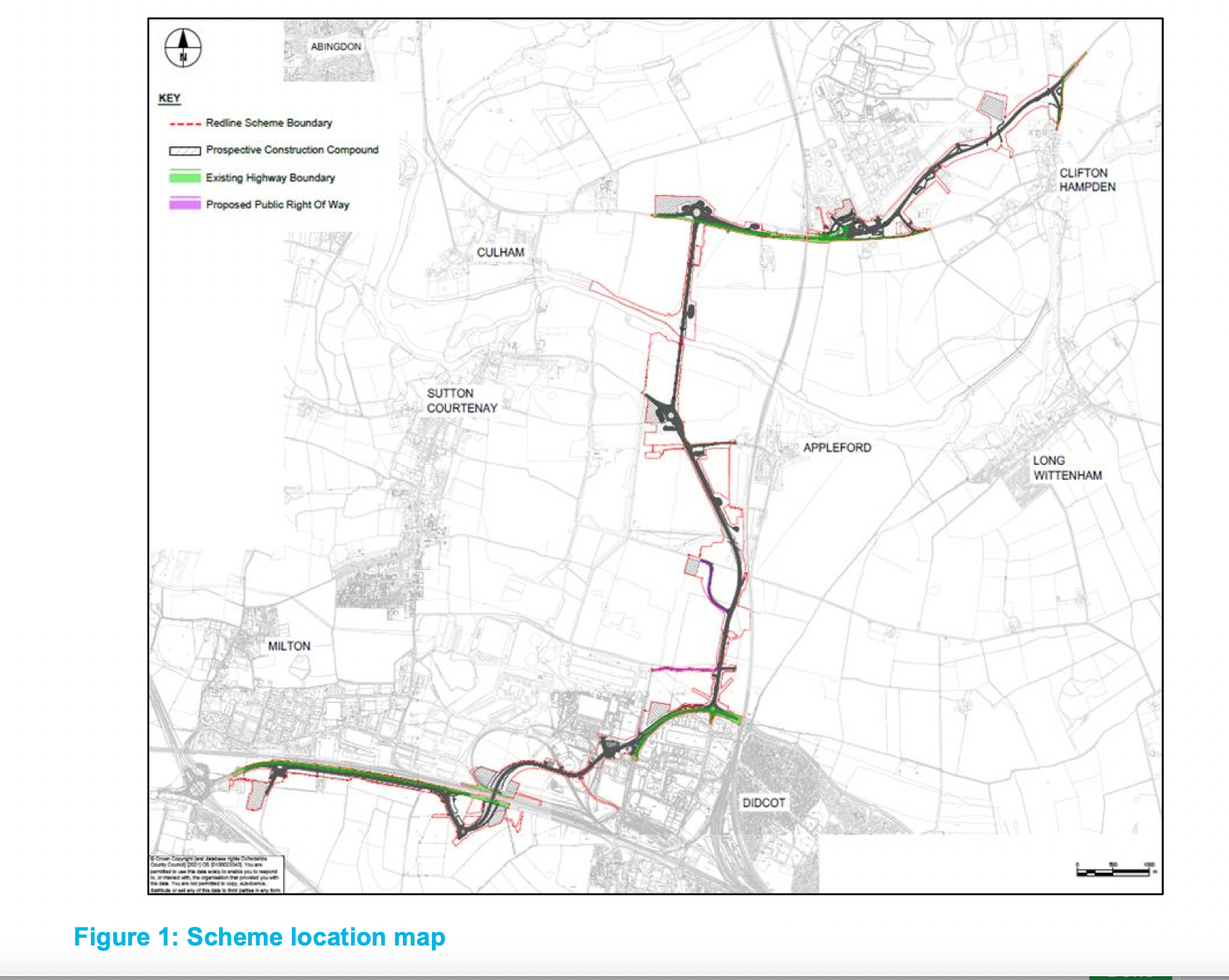
The largest and most controversial is ‘HIF1’, Oxfordshire’s first Housing Infrastructure Fund scheme. Essentially, this is a second route north from Didcot, so that the A34 doesn’t bear the brunt of all the housing planned for the area. It also serves major employment sites including Culham and Milton. The full menu comprises:
- A4130 dualling – linking Valley Park to Didcot Science Bridge
- Didcot Science Bridge – a new bridge across the railway line and the former Didcot A power station site
- Didcot to Culham River Crossing – a new link road and bridge over the River Thames
- Clifton Hampden bypass – a new bypass to re-route traffic away from Clifton Hampden and Burcot
- 12 miles of walking and cycling paths
Rampant construction inflation has affected road schemes across the country, and HIF1 is no exception. Last year the bill was estimated at £279m, but in written evidence to the public inquiry, Oxfordshire County Council has now confirmed the total as £332.5m.
Public inquiry? We’re getting ahead of ourselves. As mentioned, this is an Oxfordshire County Council project. Any building project needs planning permission. In this case, Oxfordshire County Council had to apply for planning permission to… Oxfordshire County Council. That might sound like a done deal, but it was anything but.
The (cross-party) planning committee is independent of the council’s leadership. At a meeting in July 2023, it decided not to grant permission for the road. What had changed? Partly the committee’s councillors distrusted the detail of traffic flows in Abingdon and elsewhere. Chiefly, though, they saw that Oxfordshire County Council had recently adopted policies sceptical of further road-building – and wondered why they were being asked to sign off on exactly that.
That refusal holed the plans for new housing below the waterline. To no one’s great surprise, the then Government in the form of Michael Gove “called in” the planning application: that is, he took the decision away from OCC’s planning committee, and gave it to an independent planning inspector. The resulting public inquiry sat this spring and its judgment is still awaited.
Whatever the inquiry’s outcome, ORAA’s co-chair Chris Church says Oxfordshire County Council needs to rethink its plans.
“The truth is that the HIF1 road is very poor value for money. The public money that would be spent on this road amounts to a £28k subsidy for each new planned house. That could rise to £35k if further government funding is required. This is no way to solve our housing problems. There are far better ways to deliver infrastructure for new homes than piling it all into roads. It’s time for an urgent review.”
Watlington Relief Road
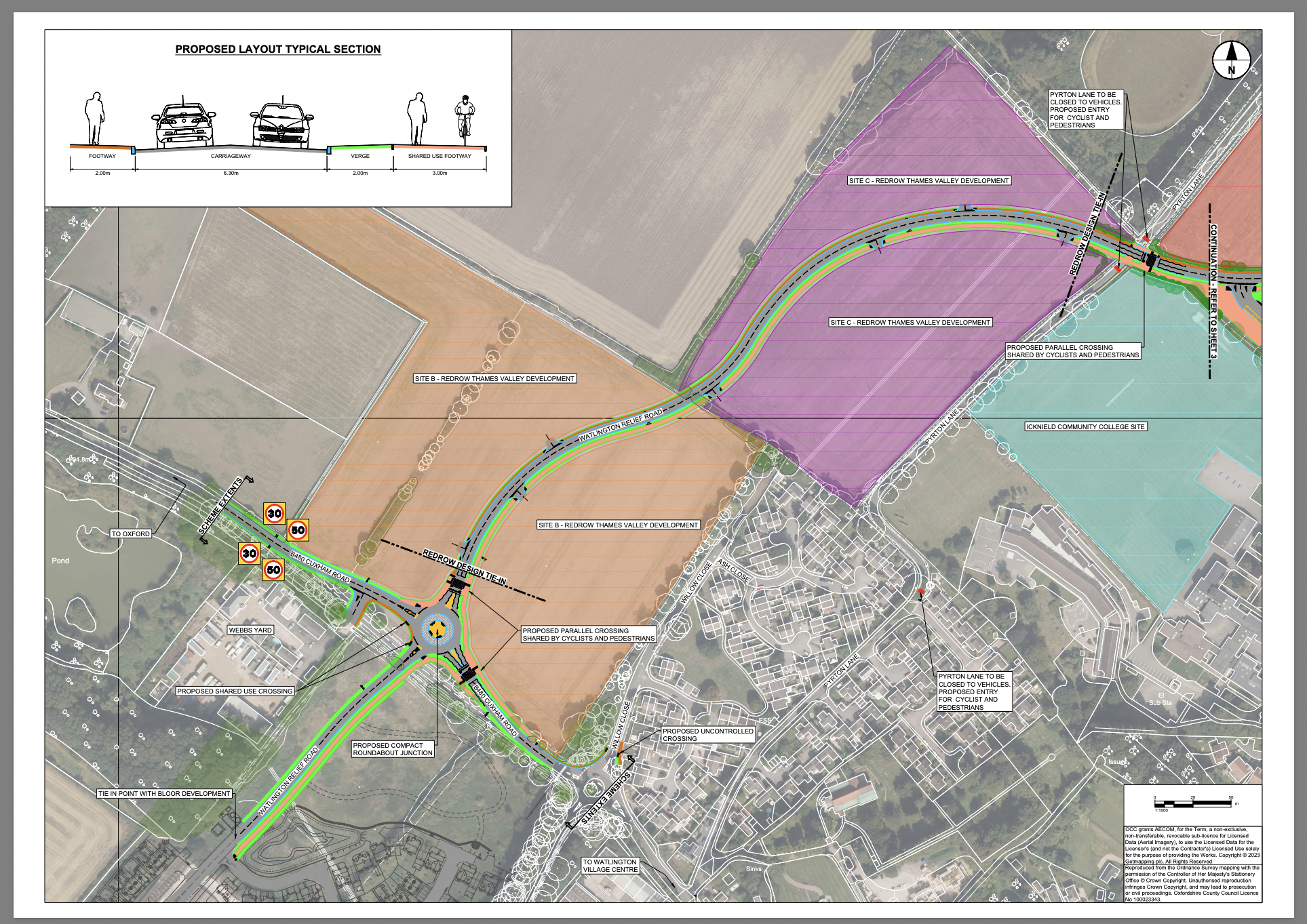
HIF1 is the most expensive scheme by a long chalk. There’s also HIF2, a series of upgrades to the A40 between Oxford and Witney. But ORAA are sounding the alarm about smaller schemes that, they say, will combine to “induce and divert more long distance traffic” through southern Oxfordshire.
The Watlington Relief Road project aims to provide an alternative route and direct access to the B4009 either side of Watlington, without going through the town centre. It has a price tag just shy of £10m. The road will connect the western side of Watlington on the B4009, looping northwards and connecting back to the B4009 on the eastern side of the town. It has cycle paths and footways built into its design.
The budget for the road was approved in 2021, but depends on funding from the Oxfordshire Housing & Growth Deal. As the name implies, this road is intended to support nearby housebuilding. The funding stream expires in March 2025, but the County Council is yet to receive the final £30m payment. County council officers wrote in July that “work is ongoing to assess the ongoing deliverability of the scheme” – suggesting a tight timescale before the deadline.
ORAA member Debbie Davies commented:
“In June, the County Council was told it had to include the effects of extra traffic if it builds an alternative road at Watlington. This change to the scope means the budget that was last approved in 2021, needs to be reconsidered by the council and low cost alternatives must be included in the review. This is the process all other government transport infrastructure schemes are undergoing for the good reason of value for public money.”
Active travel
All of these schemes include a cycling and walking component, generally a cycleway running beside the road. As you might hope for a £332m project, the cycling infrastructure coming along with HIF1 is leaps and bounds better than most of what already exists in the county. A new traffic-free cycle route from Didcot to Culham is a big win for cyclists, and the fully segregated, wide path is closer to Dutch provision than to the narrow shared paths of Oxford city. Design-wise, Oxfordshire County Council has taken lessons from best practice across the country – not the case for many road schemes going ahead elsewhere.
But ORAA says the balance is wrong. The majority of the spend on HIF1 is providing for motor vehicles – at a time when Oxfordshire County Council has adopted a transport hierarchy that places walking and cycling at the top. Spending for new roads, they say, far exceeds spending on active travel:
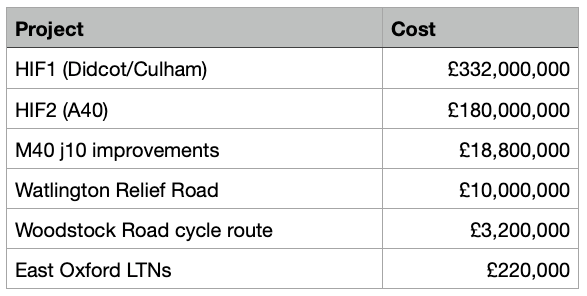
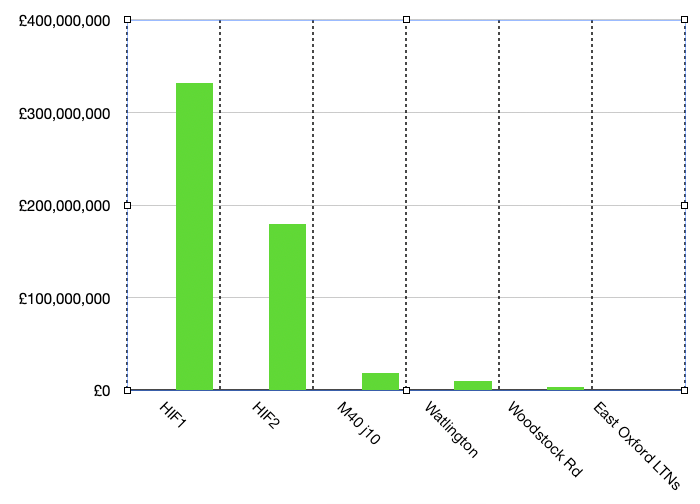
Housing-funded infrastructure projects in Oxfordshire. The East Oxford LTNs (initial cost plus bollard replacement) are not housing-funded but are included for comparison purposes.
The Local Transport and Connectivity Plan (LTCP) was adopted by Oxfordshire County Council in July 2022. It talks of encouraging active travel, with this stated ambition:
to keep people connected, and to create a net zero transport system by 2040, improving health and wellbeing, tackling the climate emergency, reducing private vehicle use and prioritising walking, cycling and the use of public transport.
Cycling groups have pointed out exasperatedly that, when projects go over budget, cycling provision gets the chop. A £12.5m plan to build a segregated cycleway along Woodstock Road would have been Oxford’s first high-quality route since the 1970s. It was dropped when road projects went over budget, replaced by a £3.2m series of incremental changes to the existing shared-use path.
The long-desired Eynsham–Botley cycleway, too, was dropped from the HIF2 programme at an early stage when central Government sounded a sceptical note. Subsequently, the promised cycleway link from the A40 to the traffic-free Oxford Canal towpath below was also cancelled, so cyclists will have to thread their way along a path around Wolvercote Roundabout.
Roads for housing
We asked Oxfordshire’s councils how building new roads fit into a vision for the county that prioritises the climate, conservation, and active travel.
South Oxfordshire and Vale of White Horse are the two districts whose new residents are expected to use roads like HIF1. As planning authorities, they have to plan where new housing will go, and assess the planning applications for these new houses. In a joint statement, they responded:
“We support essential transport infrastructure such as HIF1 and the Watlington Relief Road to support our existing communities, as well as helping deliver new sustainable housing and economic sites that are already identified in the district’s adopted Local Plan. New transport infrastructure should enable public transport and encourage active travel, which the HIF1 will achieve through a segregated cycleway which allow cyclists to avoid country lanes and travel more safely. The Watlington Relief Road will also help reduce congestion in the centre of Watlington which will result in cleaner air and contribute to our ambition in becoming a net zero district.
“Moving forwards, we will continue to press for the need to maximise biodiversity and more than mitigate the impact of any development and infrastructure schemes on the district’s natural and historic landscape, including the River Thames.
“We also recognise the details are also important and continue to make the case for high quality design throughout as set out in the South Oxfordshire Design Guide and in the Didcot Garden Town Delivery Plan.”
As the highway authority for the county, Oxfordshire County Council is promoting schemes such as HIF1 and the Watlington Relief Road. Its cabinet member for major infrastructure schemes is Judy Roberts, who said:
“All major schemes are regularly reviewed for deliverability as a matter of course. This is to ensure that the capital programme as a whole remains aligned to the latest priorities, reflects the latest cost projections and profile for delivery, and incorporates current funding positions.
“Both the HIF1 (Didcot and surrounding areas) and Watlington relief road schemes are part of a wider strategy to facilitate housing, employment and population growth across South Oxfordshire and the Vale of White Horse. Both schemes directly deliver and indirectly enable a significant number of new and improved walking and cycling routes in the area.
“HIF1 will provide approximately 20km of new segregated off-carriageway cycling and pedestrian infrastructure. The scheme will also improve bus journey reliability and allow for new bus services to run. Watlington Relief Road will provide 3.3km of shared off-carriageway cycling and walking infrastructure.
“The case for the HIF1 scheme was recently heard as part of a conjoined public inquiry. Evidence submitted to the inquiry can be viewed on the official inquiry portal - https://gateleyhamer-pi.com/en-gb/didcot-garden-town/
“A planning application (ref R3.0010/24) for the Watlington Relief Road was submitted in December 2023. We anticipate a planning decision in January 2025.”
The last of its breed?
Without Googling, who do you think wrote this?
There are situations where new roads, or widening roads and junctions may be necessary, but this is not a sustainable long term solution because we have found that road schemes often generate new demand and quickly reach capacity again.
Full marks if you guessed Oxfordshire County Council. It’s part of Policy 36 of OCC’s Local Transport & Connectivity Plan, adopted in 2022.
Councils work on long timescales, often longer than individual politicians’ time at the top. The groundwork for what’s now HIF1 was laid in 2014 and 2015, when the county council had a very different political hue.
The Oxfordshire Roads Action Alliance argues that times have changed and that “it’s time for a fresh perspective”. They say that the massive spending on new roads, compared to the much smaller amounts on active travel, sits in stark contrast to OCC’s stated policy.
Oxfordshire’s councils find themselves stuck between a rock and a hard place. Signed up to housing targets imposed by central Government, inheriting plans and agreements drawn up by previous councils, they cannot simply pull out – or the decisions will be taken away from them. Michael Gove’s decision to “call in” the first sniff of opposition to the scheme was a first taste, but a Labour government determined to build 1.5m more homes is unlikely to be any more lenient.
For ORAA and the residents of rural southern Oxfordshire fearful of the extra traffic that new roads may bring, stopping HIF1 is the immediate worry. But perhaps Oxfordshire’s next challenge is working out how to provide thousands more homes without a HIF3, HIF4 and HIF5.
In a special series next week, the Oxford Clarion will be looking in depth at the challenge of building new housing in Oxfordshire – and the pressures on transport, the environment and more.
